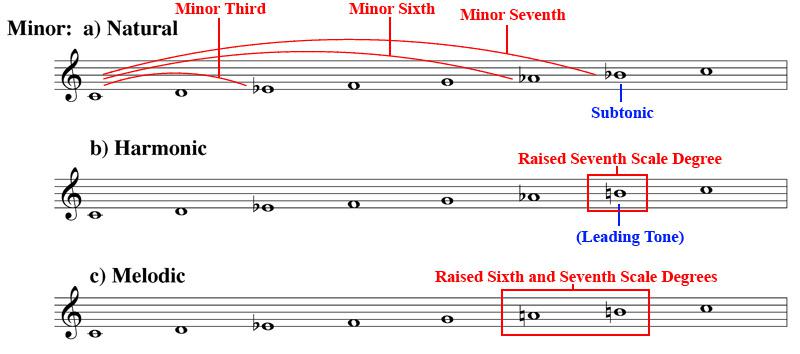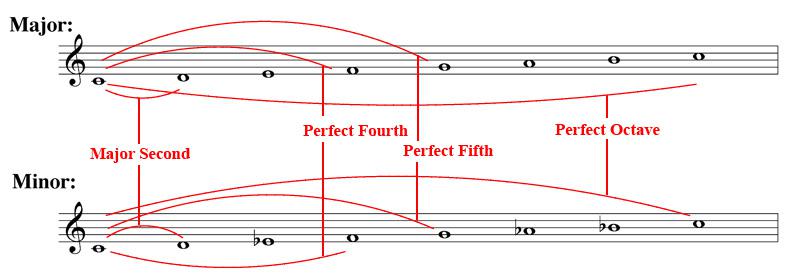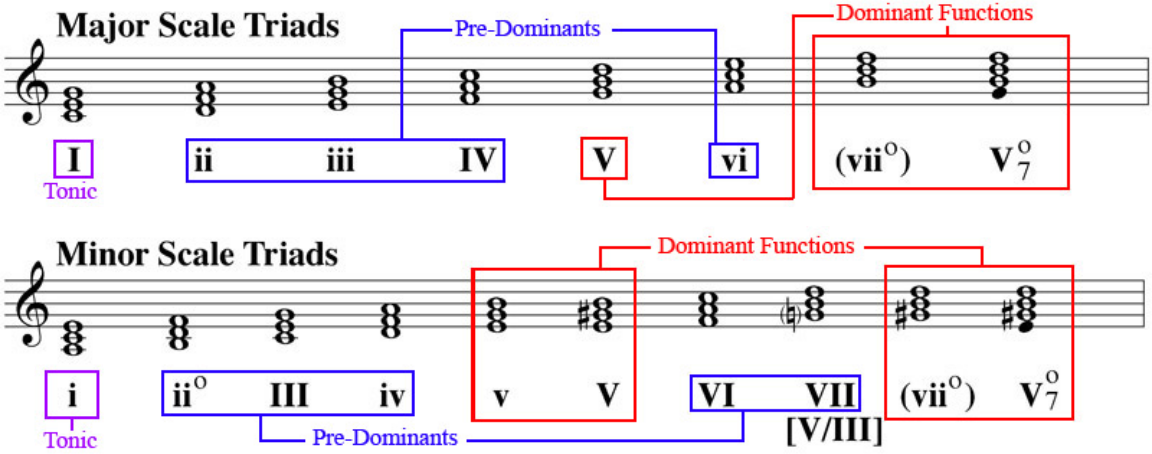25 Common Practice Era Scales, Intervals, and Chord Functions
At the dawn of the 17th century the system of modes that composers used exclusively from the medieval period onwards began to go through a process of change brought about by the emergence of functional harmony and the concept of modulation. By the end of the century modes had been for the most part replaced by a system of two transposable keys: the major and the minor. Although each had roots in the modal system, their implementation would create an entirely new paradigm for structuring musical composition.
Key Systems and Terminology: The names given to each of the two keys systems is based on the quality of their tonic triads. As well, each scale step is designated by a name and number. For instance, the second scale degree (of both major and minor) is called the supertonic. This degree can also be indicated by a “2” with a small caret mark above it. The only degree designation not common to both key systems is the seventh. Since in the natural minor scale there is a whole-step between this degree and the tonic rather than a half-step, it is called a subtonic (rather than leading tone).
Major. The distinguishing factors of any scale are dependent upon the intervals between each of its steps. For example, in major, the sequence of intervals is whole-step, whole-step, half-step, whole-step, whole-step, whole-step, half-step while in minor (natural) it is whole-step, half-step, whole-step, whole-step, half-step, whole-step, whole-step.
Intervals were assigned labels based on the scale from which they arose. For instance, in major there are four half-steps (or semitones) between the tonic and mediant while in minor there are only three. Therefore, the interval of four diatonic half-steps is referred to as a major third, while that of three half-steps is a minor third.

Minor. The minor key system has three variants: a) Natural, b) Harmonic, and c) Melodic. The harmonic minor scale includes a raised seventh scale degree, which enables it to function as a leading tone (as similar to the major system). The melodic minor scale includes a raised sixth as well as seventh scale degree.

Some theorists erroneously indicate that the melodic minor scale has two different forms, depending on whether it is ascending or descending. However, as we can observe in countless examples from the literature, this is a misconception. The following canon subject from The Art of the Fugue by J.S. Bach illustrates how melodic minor employs the raised sixth and seventh scale degrees in both ascending and descending passages.

Other Interval Names. The intervals that are identical in both major and minor (natural) are the second, fourth, fifth, and octave. The only simple interval that remains without a term as derived from scale steps is the smallest interval within the Western tradition: the minor second (one semitone).

Table of Simple Intervals
|
Interval Name (Analytic Shorthand) |
Semitones |
|
Perfect unison (P0) |
0 |
|
Minor second (m2) |
1 |
|
Major second (M2) |
2 |
|
Minor third (m3) |
3 |
|
Major third (M3) |
4 |
|
Perfect fourth (P4) |
5 |
|
Tritone: Augmented fourth (A4)/diminished fifth (d5) |
6 |
|
Perfect fifth (P5) |
7 |
|
Minor sixth (m6) |
8 |
|
Major sixth (M6) |
9 |
|
Minor seventh (m7) |
10 |
|
Major seventh (M7) |
11 |
|
Perfect octave (P8) |
12 |
Note that in the analytic shorthand notation, perfect, augmented, and major intervals are indicated with capital letters, while diminished and minor intervals are specified with lower case letters.
Complex Intervals. Intervals that span an amount of semitones different than the number possible associated with said diatonic interval are called either augmented or diminished intervals. For instance, three semitones would normally be associated with three scale steps (a minor third). However, if there are only two scale steps (as in the example below), the three semitones exceeds the greatest amount of semitones possible within a diatonic second and therefore must be referred to as an augmented second.
Conversely, if there are fewer semitones than regularly associated with a particular simple interval, that interval would be designated as being diminished. In the second example below, we have seven scale steps between the two pitches F# and Eb, yet only nine semitones. Since this is less than the smallest number of semitones possible in a diatonic seventh, it is referred to as a diminished seventh. Although it is enharmonic (meaning they sound the same) with a major sixth, it cannot be labeled as such since there are more than six scale steps between the two notes.
One commonly used interval known as the tritone has two possible articulations: a diminished fifth or an augmented fourth. Although they are enharmonic, their specific spellings can indicate different contexts and possible resolutions.

Chord Functions. Each scale step can act as the root of a triad. Individually, however, triads have no true musical meaning until they are sounded sequentially and establish relationships with one another. Over the course of the Common Practice Era hierarchical tonal structures, known as functional harmony, evolved. The concepts governing the manner in which functional harmony operates became the fundamental source of temporal drama and the underpinning of the musical forms that arose from the period. For a concise description of how these chords interact in the Common Practice read the chapter on The Forces of Tonal Harmony. Here, we are more concerned with understanding the sonorities themselves within each key system and how they can be interpreted.
Triads. In both the major and minor, we can classify every chord as belonging to one of three categories: Tonic, Dominants, or Pre-Dominants. The tonic is built from the first scale degree and the pre-dominants on the second, third, fourth, and sixth. Although the qualities of each of these chords differ depending on whether the key is major or minor, the manner in which the sonorities function within the context of chord progressions is identical.
In a major key the fifth scale degree is a major triad and functions as the dominant. In a minor key this chord is minor. However, it is usually altered to sound as a major triad (by raising the third of the chord), which enables the sonority to operate significantly more as a dominant function.
The seventh scale degree has two interpretations, and we will explore both sides of the argument. Some theorists label it as a vii dim. chord, which indicates that the seventh scale degree functions as the root. However, since it behaves the same as a V7 chord (without the root) it can be labeled as such and is known as a rootless dominant chord. The first solution is based on taking into account only the articulated components of the chord and the quality of its sound, while the second is more concerned with how it functions.
One final issue is the seventh scale degree in a minor key in which the root is not raised. The VII chord usually functions in this case in one of two ways. First, it is often part of a descending chord pattern the develops between the tonic and dominant: i – VII – VI – V, in which case it functions as a pre-dominant. As well, it can be used as a secondary dominant to the relative major: V/III.

Seventh Chords. Of course any triad can have a seventh added (either diatonic or chromatic). However, in the Common Practice Era, only the second, fifth and seventh scale degrees often include this added tone. In both the major and minor key systems the ii7 functions as a terminal pre-dominant chord (meaning that it has a strong pull to the dominant). The dominant with an added seventh simply increases the force of the chord towards the tonic.
The seventh scale degree once again is a point of debate. As before it can be regarded as a rootless dominant, so a vii7 can be labeled as a dominant with an added ninth, but with a missing root (or a rootless dominant seventh chord). In the Common Practice Era, in minor as well as major that ninth is normally flatted and would subsequently resolve to the fifth of the tonic chord.


